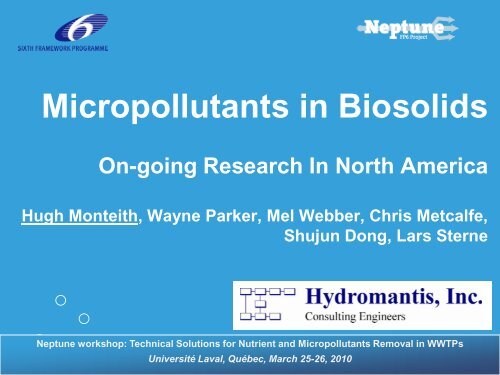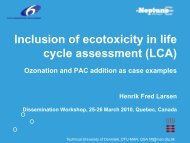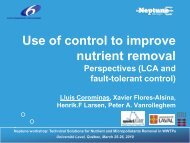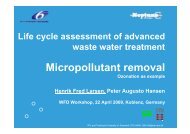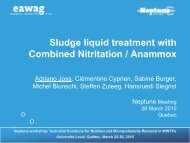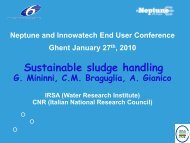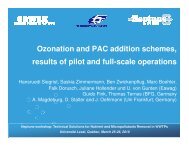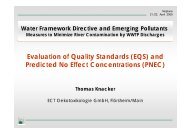Micropollutants in Biosolids - EU Project Neptune
Micropollutants in Biosolids - EU Project Neptune
Micropollutants in Biosolids - EU Project Neptune
You also want an ePaper? Increase the reach of your titles
YUMPU automatically turns print PDFs into web optimized ePapers that Google loves.
<strong>Micropollutants</strong> <strong>in</strong> <strong>Biosolids</strong><br />
On-go<strong>in</strong>g Research In North America<br />
Hugh Monteith, Wayne Parker, Mel Webber, Chris Metcalfe,<br />
Shujun Dong, Lars Sterne<br />
<strong>Neptune</strong> workshop: Technical Solutions for Nutrient and <strong>Micropollutants</strong> Removal <strong>in</strong> WWTPs<br />
Université Laval, Québec, March 25-26, 2010<br />
(Name and logo of Your Institution)
Presentation Outl<strong>in</strong>e<br />
• Historical focus of MPs <strong>in</strong> biosolids <strong>in</strong><br />
Canada<br />
• Some Canadian results<br />
• Ongo<strong>in</strong>g studies <strong>in</strong> Canada<br />
• Studies <strong>in</strong> U.S./North America<br />
• Brief summary<br />
<strong>Neptune</strong> Workshop, Université Laval, Québec, March 25-26, 2010
Historical Context <strong>in</strong> Canada<br />
• Prior to mid-1970s, focus was on metallic<br />
pollutants and potential uptake <strong>in</strong> crops &<br />
livestock after biosolids amendment<br />
• Mid-late 1970s, PCBs <strong>in</strong>vestigated for<br />
translocation from biosolids-amended soils<br />
to plant crops<br />
• 1980s-1990s focused on “priority pollutants”,<br />
<strong>in</strong>clud<strong>in</strong>g solvents, pesticides, PAHs,<br />
phenolics and chlor<strong>in</strong>ated aromatics<br />
– Publications of Webber and colleagues<br />
<strong>Neptune</strong> Workshop, Université Laval, Québec, March 25-26, 2010
More Recent History<br />
• Start<strong>in</strong>g about 2002-03, Dr. H-B (Bill) Lee<br />
and colleagues of Environment Canada<br />
began report<strong>in</strong>g concentrations of EDCs &<br />
PPCPs <strong>in</strong> biosolids<br />
– Mostly anaerobically digested solids<br />
• Ca. 2005, Trent University (Dr. C. Metcalfe<br />
and colleagues) start report<strong>in</strong>g<br />
concentration data for PPCPs <strong>in</strong> biosolids<br />
<strong>Neptune</strong> Workshop, Université Laval, Québec, March 25-26, 2010
Bisphenol A <strong>in</strong> Canadian Sludges<br />
BPA Concentration (ng/g TS)<br />
Raw Sludge<br />
Digested <strong>Biosolids</strong><br />
# WWTPs 11 21<br />
# Samples 12 23<br />
Median 280 555<br />
Range 130-39,800 130-11,100<br />
<strong>Neptune</strong> Workshop, Université Laval, Québec, March 25-26, 2010<br />
(Lee and Peart, 2002)
Alkylphenol Ethoxylates<br />
Compound<br />
Concentration<br />
(μg/g TS)<br />
Median<br />
raw<br />
(Lee and Peart, 2002)<br />
Median<br />
digested<br />
Removal<br />
(%)<br />
4-nonylphenol (NP) 91.5 413 -351%<br />
NP mono-EO (NP1EO) 61.9 83.7 -35%<br />
*<br />
NP di-EO (NP2EO) 35.2 24.8 29%<br />
NP tri-EO (NP3EO) 13.8 6.9 50%<br />
Higher NP-EOs NP(4-17)EO 43.5 11.3 74%<br />
4-tert-octylphenol 4.75 10.4 -119%<br />
<strong>Neptune</strong> Workshop, Université Laval, Québec, March 25-26, 2010<br />
*
Triclosan<br />
Triclosan Concentration<br />
(ng/g TS)<br />
Raw Sludge<br />
Digested <strong>Biosolids</strong><br />
# WWTPs 11 21<br />
# Samples 12 23<br />
Median 10,600 14,450<br />
Range 3,430-17,900 900-28,200<br />
(Lee and Peart, 2002)<br />
<strong>Neptune</strong> Workshop, Université Laval, Québec, March 25-26, 2010
Fragrance Compounds<br />
Compound<br />
Median Conc„n<br />
(ng/g TS)<br />
Raw<br />
Digested<br />
<strong>Neptune</strong> Workshop, Université Laval, Québec, March 25-26, 2010<br />
(Lee et al., 2003)<br />
Removal<br />
(%)<br />
Galaxolide (HHCB) 11,850 14,500 -22.4<br />
Tonalide (AHTN) 8010 12300 -53.7<br />
Celestolide (ADBI) 175 320 -82.9<br />
Phantolide (AHDI) 110 120 -9.1<br />
Traesolide (ATII) 1345 1870 -39.0<br />
Musk Xylene (MX) 19 3.3 82.6<br />
Musk Ketone (MK) 145 4.5 96.9<br />
*<br />
*
Fragrance Compounds (Yang & Metcalfe,<br />
2005)<br />
Compound<br />
Median Conc„n<br />
(ng/g TS)<br />
Raw<br />
Digested<br />
<strong>Neptune</strong> Workshop, Université Laval, Québec, March 25-26, 2010<br />
Removal<br />
(%)<br />
Galaxolide (HHCB) 3,300 6,790 -106<br />
Tonalide (AHTN) 720 1,350 -88<br />
Celestolide (ADBI) 23.6 51.2 -117<br />
Phantolide (AHDI) 20.1 33.8 -68<br />
Traesolide (ATII) 199 413 -108<br />
Musk Xylene (MX) 76.6 95.1 -24<br />
Musk Ketone (MK) 39.8 53.0 -33
Carbamazep<strong>in</strong>e<br />
Carbamazep<strong>in</strong>e or<br />
Metabolite<br />
Concentration (ng/g TS)<br />
Raw sludge<br />
Anaerobic<br />
digested<br />
sludge<br />
Removal %<br />
Carbamazep<strong>in</strong>e 69.6 ±2.2 a 258 ±4.7 -271%<br />
2-hydroxycarbamazep<strong>in</strong>e<br />
1.9 ±1.1 3.4 ±0.9 -79%<br />
3-hydroxycarbamazep<strong>in</strong>e<br />
1.6 ±0.8 4.3 ±0.9 -169%<br />
(n=3)<br />
a<br />
mean ± standard deviation<br />
Miao et al. (2005)<br />
<strong>Neptune</strong> Workshop, Université Laval, Québec, March 25-26, 2010
Current Research Efforts<br />
• Canada<br />
– CCME<br />
– Environment Canada<br />
– Water Environment Association of Ontario<br />
• U.S. North America<br />
– Water Environment Federation<br />
– Water Environment Research Foundation<br />
– U.S. EPA<br />
<strong>Neptune</strong> Workshop, Université Laval, Québec, March 25-26, 2010
CCME – Who They Are & Mandate<br />
• Canadian Council of M<strong>in</strong>isters of the<br />
Environment represents the 14 Environment<br />
M<strong>in</strong>isters of the Canadian federal<br />
government, 10 Prov<strong>in</strong>ces and 3 Territories<br />
• CCME is responsible for the coord<strong>in</strong>ation of<br />
national environmental issues, such as:<br />
– harmonization of municipal effluent compliance,<br />
– acid ra<strong>in</strong> policy, and<br />
– Codes of Practice (e.g. petroleum storage<br />
tanks).<br />
<strong>Neptune</strong> Workshop, Université Laval, Québec, March 25-26, 2010
CCME Efforts: Coord<strong>in</strong>ation of<br />
Micropollutant Research <strong>in</strong> WW & <strong>Biosolids</strong><br />
• Recognized that many academic <strong>in</strong>stitutions and<br />
agencies are <strong>in</strong>volved <strong>in</strong> MP research<br />
• Research fund<strong>in</strong>g is scarce, so duplication of<br />
efforts needs to be avoided<br />
• Hosted a 1-day workshop Dec. 2 <strong>in</strong> Ottawa<br />
• Sixty participants, attended, represent<strong>in</strong>g:<br />
– science research associations,<br />
– NGO‟s,<br />
– <strong>in</strong>dustry/bus<strong>in</strong>ess,<br />
– academia and<br />
– government<br />
<strong>Neptune</strong> Workshop, Université Laval, Québec, March 25-26, 2010
CCME Efforts: Coord<strong>in</strong>ation of<br />
Micropollutant Research <strong>in</strong> WW & <strong>Biosolids</strong><br />
• Science and research co-ord<strong>in</strong>ation<br />
activities of a new national body<br />
– Based on your organization‟s needs, what<br />
would be useful functions for a research coord<strong>in</strong>ation<br />
body?<br />
• Information co-ord<strong>in</strong>ation and dissem<strong>in</strong>ation;<br />
• Research priority-sett<strong>in</strong>g activities;<br />
• Active identification of collaboration opportunities;<br />
• Fund<strong>in</strong>g research <strong>in</strong> identified priority areas;<br />
• Other functions<br />
– What do you see as the current challenges to<br />
undertak<strong>in</strong>g the above activities?<br />
<strong>Neptune</strong> Workshop, Université Laval, Québec, March 25-26, 2010
CCME Efforts: Coord<strong>in</strong>ation of<br />
Micropollutant Research <strong>in</strong> WW & <strong>Biosolids</strong><br />
• Governance and Fund<strong>in</strong>g<br />
– What would be the most workable governance<br />
structure for a research co-ord<strong>in</strong>at<strong>in</strong>g body?<br />
– Should the identified functions be undertaken by<br />
one body, or could they be divided among<br />
several organizations? New organization or<br />
exist<strong>in</strong>g?<br />
– Fund<strong>in</strong>g Options (who provides the fund<strong>in</strong>g?)<br />
General consensus was to keep this process mov<strong>in</strong>g<br />
forward and not let it rema<strong>in</strong> an academic exercise.<br />
<strong>Neptune</strong> Workshop, Université Laval, Québec, March 25-26, 2010
CCME Efforts: Concentrations of MPs<br />
and Effects of <strong>Biosolids</strong> Treatment<br />
• No focused study has been completed yet on an<br />
<strong>in</strong>ventory of MPs <strong>in</strong> Canadian biosolids<br />
• Complete a targeted sampl<strong>in</strong>g program which will<br />
provide a basis for CCME to evaluate and manage<br />
the risks associated with MPs <strong>in</strong> biosolids with<br />
respect to:<br />
– managed land application,<br />
– land reclamation,<br />
– production of commercial soil amendments and<br />
– energy production<br />
<strong>Neptune</strong> Workshop, Université Laval, Québec, March 25-26, 2010
• Year 1: literature review of micropollutants <strong>in</strong><br />
raw sludges and treated biosolids, and<br />
removal through treatment processes<br />
(complete)<br />
– 121 pages<br />
CCME Efforts: Concentrations of MPs<br />
and Effects of <strong>Biosolids</strong> Treatment<br />
– Posted at:<br />
http://www.ccme.ca/assets/pdf/pn_1440_<br />
contam_<strong>in</strong>vt_rvw.pdf<br />
<strong>Neptune</strong> Workshop, Université Laval, Québec, March 25-26, 2010
CCME Efforts: Concentrations of MPs<br />
and Effects of <strong>Biosolids</strong> Treatment<br />
• Year 2: field study of 11 sites across Canada<br />
us<strong>in</strong>g different techniques for produc<strong>in</strong>g solids<br />
for land amendment<br />
• Anaerobic digestion<br />
• Autothermal aerobic digestion<br />
• Compost<strong>in</strong>g<br />
• Alkal<strong>in</strong>e stabilization<br />
• Heat dry<strong>in</strong>g<br />
• Dewater<strong>in</strong>g by filter presses and by geotextile bags<br />
– 57 Pharmas and PCPs, fragrances, alkylphenols, metals<br />
– Draft Report review complete and revisions <strong>in</strong> progress<br />
– Report posted on CCME website <strong>in</strong> April or May (?)<br />
<strong>Neptune</strong> Workshop, Université Laval, Québec, March 25-26, 2010
Environment Canada Efforts<br />
• Authorized by Chemicals Management<br />
Plan under Canadian Environmental<br />
Protection Act (CEPA)<br />
• Monitor<strong>in</strong>g of wastewater samples and<br />
solids for MPs<br />
– Alkylphenols, parabens, pharmaceuticals,<br />
– Perfluor<strong>in</strong>ated organics, brom<strong>in</strong>ated flame<br />
retardants (PBDES + 4 others)<br />
– Volatile methyl siloxanes (D4, D5, D6)<br />
– 18 metals/metalloids<br />
<strong>Neptune</strong> Workshop, Université Laval, Québec, March 25-26, 2010
Environment Canada CMP Study<br />
• 20 WWTPs across Canada<br />
• Primary, secondary, advanced, and lagoon<br />
treatment<br />
• About 10% of the Canadian population<br />
• Two campaigns<br />
– Cold temperatures (January to May) ongo<strong>in</strong>g<br />
– Warm temperatures (June to November) over<br />
• Contact Shirley Anne Smyth<br />
– (905) 336-4509; ShirleyAnne.Smyth@ec.gc.ca<br />
<strong>Neptune</strong> Workshop, Université Laval, Québec, March 25-26, 2010
WEAO Effort<br />
• Water Environment Assoc‟n of Ontario<br />
• Literature review of micropollutants<br />
(<strong>in</strong>clud<strong>in</strong>g pathogens) <strong>in</strong> biosolids and fate<br />
and effects <strong>in</strong> terrestrial environment<br />
• Update of a review completed <strong>in</strong> 2001<br />
• 200+ page report completed Dec. 2009<br />
• Peer-reviewed by North American experts<br />
to confirm accuracy and completeness<br />
• Will be posted on WEAO website<br />
(www.weao.org) after public consultation<br />
<strong>Neptune</strong> Workshop, Université Laval, Québec, March 25-26, 2010
Water Environment Federation<br />
• Microconstituent Community of Practice (COP)<br />
• Chair: Joe Cleary, HydroQual, Inc.<br />
• Issue Leaders<br />
– Occurrence: Dr. Tom Granato, Metro Chicago<br />
– Analytical: Ak<strong>in</strong> Babatola, Santa Cruz, CA<br />
– Treatment: Rich Edwards, Pfizer, Inc.<br />
– Fate and Transport: Dr. Mary Buzby, Merck & Co.<br />
– Communications: L<strong>in</strong>da MacPherson, CH2M-Hill<br />
– Effects: Diana Eignor, U.S. EPA<br />
• WEF Liaison: Bonnie Bailey<br />
<strong>Neptune</strong> Workshop, Université Laval, Québec, March 25-26, 2010
WEF Microconstituent COP Activities<br />
• Development of webcasts<br />
• Development of Technical Practice Updates<br />
(TPUs)<br />
• Sessions <strong>in</strong> WEFTEC10 Technical Program<br />
• Development of Bi-annual Jo<strong>in</strong>t Micro-Con<br />
and Industrial Water Quality Conference<br />
• Development of a collaborative outreach<br />
program with other organizations (e.g.<br />
SETAC, AWWA) to work together on topics<br />
of common <strong>in</strong>terest.<br />
<strong>Neptune</strong> Workshop, Université Laval, Québec, March 25-26, 2010
WEF Microconstituent COP Webcasts<br />
• Oct 2009, Jo<strong>in</strong>t Webcast with the Society of<br />
Environmental Toxicology and Chemistry<br />
(SETAC):<br />
Microconstituents <strong>in</strong> the Aquatic<br />
Environment: Impacts for Wastewater<br />
Utilities<br />
• Dec 2009, Microconstituents <strong>in</strong> <strong>Biosolids</strong><br />
• 2010(?), Microconstituents <strong>in</strong> Water Reuse<br />
<strong>Neptune</strong> Workshop, Université Laval, Québec, March 25-26, 2010
WEF Microconstituent COP Technical<br />
Practice Updates (TPUs)<br />
• Available at www.wef.org<br />
• Analytical Methods and Monitor<strong>in</strong>g Technologies<br />
for MCs<br />
• Current Regulatory Framework for MCs <strong>in</strong> Water<br />
• Effects of Wastewater Treatment on MCs<br />
• MCs <strong>in</strong> <strong>Biosolids</strong><br />
• Nanoparticles<br />
• Source Control of MCs<br />
• Sources of MCs and EDCs<br />
• MCs <strong>in</strong> the Water Environment – A Resource<br />
Paper for Public and Press<br />
<strong>Neptune</strong> Workshop, Université Laval, Québec, March 25-26, 2010
WEF COP TPU on MCs <strong>in</strong> <strong>Biosolids</strong><br />
(July 2007)<br />
• Contam<strong>in</strong>ants reviewed were<br />
pharmaceuticals, brom<strong>in</strong>ated flame<br />
retardants, plastics & plasticizers, musks &<br />
fragrances<br />
• Regulatory status <strong>in</strong> U.S. and <strong>EU</strong><br />
• Methodologies for assess<strong>in</strong>g MCs <strong>in</strong><br />
biosolids<br />
• Summarized current research status and<br />
future directions<br />
<strong>Neptune</strong> Workshop, Université Laval, Québec, March 25-26, 2010
Water Environment Research<br />
Foundation (WERF)<br />
• Fate of Estrogenic Compounds dur<strong>in</strong>g<br />
Municipal Sludge Stabilization & Dewater<strong>in</strong>g<br />
– WERF <strong>Project</strong> #04-HHE-6<br />
• WERF <strong>Project</strong> Manager Alan Hais<br />
– (703) 684-2470; ahais@werf.org<br />
• Work led by AECOM and US Geological<br />
Survey<br />
– Study is <strong>in</strong> progress<br />
<strong>Neptune</strong> Workshop, Université Laval, Québec, March 25-26, 2010
WERF Study of Estrogenic Compounds<br />
<strong>in</strong> Municipal Sludge Stabilization<br />
• Establish identity, characteristics,<br />
concentrations, temporal/seasonal variations<br />
and estrogenic potency <strong>in</strong> biosolids dur<strong>in</strong>g<br />
different treatment processes<br />
• Exam<strong>in</strong>e effect of sludge treatment and<br />
dewater<strong>in</strong>g processes on estrogenic<br />
compounds and estrogenic activity<br />
• Targeted full- and pilot/bench-scale studies<br />
• Phase II will exam<strong>in</strong>e other trace contam<strong>in</strong>ants<br />
<strong>Neptune</strong> Workshop, Université Laval, Québec, March 25-26, 2010
U.S. EPA<br />
• U.S Targeted National Sewage Sludge<br />
Survey (TNSSS)<br />
• Released <strong>in</strong> 2009<br />
– 74 POTWs, >1 MGD, secondary treatment or<br />
better <strong>in</strong> contiguous U.S.<br />
– Tested for 25 metals, 11 PBDEs, 97<br />
pharmaceuticals, steroids and hormones (and<br />
others) <strong>in</strong> 84 samples<br />
• <strong>Project</strong> contact Rick Stevens<br />
– (202) 566-1135<br />
– stevens.rick@epa.gov<br />
<strong>Neptune</strong> Workshop, Université Laval, Québec, March 25-26, 2010
U.S. EPA TNSSS<br />
• Of 72 pharmaceuticals, 3 (ciprofloxac<strong>in</strong>,<br />
diphenhydram<strong>in</strong>e and triclocarban) were<br />
found <strong>in</strong> all 84 samples; 9 were found <strong>in</strong> at<br />
least 80 of the samples<br />
• 10 of 11 PBDEs were found <strong>in</strong> all samples<br />
• 17-α-eth<strong>in</strong>yl-estradiol not found <strong>in</strong> any<br />
samples<br />
• Reference:<br />
www.epa.gov/waterscience/biosolids/tnsss-overview.html<br />
<strong>Neptune</strong> Workshop, Université Laval, Québec, March 25-26, 2010
Summary<br />
• Concentrations and potential effects of<br />
MPs <strong>in</strong> biosolids are a concern <strong>in</strong> North<br />
America because land application is an<br />
important management alternative<br />
• Substantial research effort is go<strong>in</strong>g on <strong>in</strong><br />
Canada and the U.S.<br />
• Occurrence of MPs <strong>in</strong> biosolids is<br />
becom<strong>in</strong>g better characterized<br />
– Fate and effects of MPs <strong>in</strong> terrestrial<br />
environment are generally not well understood<br />
<strong>Neptune</strong> Workshop, Université Laval, Québec, March 25-26, 2010
The End<br />
• Thank you for your attention!<br />
• Hugh Monteith<br />
– (613) 334-9841<br />
– Monteith@hydromantis.com<br />
?<br />
?<br />
?<br />
?<br />
?<br />
? ?<br />
?<br />
?<br />
?<br />
?<br />
? ?<br />
?<br />
?<br />
?<br />
?<br />
?<br />
?<br />
<strong>Neptune</strong> Workshop, Université Laval, Québec, March 25-26, 2010


